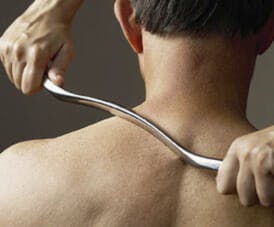Active Release Techniques® (ART)
ART is a patented, state-of-the-art soft tissue system/movement based massage technique that treats problems with muscles, tendons, ligaments, fascia and nerves. Headaches, back pain, carpal tunnel syndrome, shin splints, shoulder pain, sciatica, plantar fasciitis, knee problems, and tennis elbow are just a few of the many conditions that can be resolved quickly and permanently with ART. These conditions all have one important thing in common: they are often a result of overused muscles.
How do overuse conditions occur?Over-used muscles (and other soft tissues) change in three important ways:
- Acute conditions (pulls, tears, collisions, etc.),
- Accumulation of small tears (micro-trauma)
- Not getting enough oxygen (hypoxia)
Each of these factors can cause your body to produce tough, dense scar tissue in the affected area. This scar tissue binds up and ties down tissues that need to move freely. As scar tissue builds up, muscles become shorter and weaker, tension on tendons causes tendonitis, and nerves can become trapped. This can cause reduced range of motion, loss of strength, and pain. If a nerve is trapped you may also feel tingling, numbness, and weakness.
What is an ART Treatment Like?Every ART session is actually a combination of examination and treatment. The ART provider uses his or her hands to evaluate the texture, tightness and movement of muscles, fascia, tendons, ligaments and nerves. Abnormal tissues are treated by combining precisely directed tension with very specific patient movements.
These treatment protocols - over 500 specific moves - are unique to ART. They allow providers to identify and correct the specific problems that are affecting each individual patient. ART is not a cookie-cutter approach.
What is the History of Active Release Techniques?ART has been developed, refined, and patented by P. Michael Leahy, DC, CCSP. Dr. Leahy noticed that his patients' symptoms seemed to be related to changes in their soft tissue that could be felt by hand. By observing how muscles, fascia, tendons, ligaments and nerves responded to different types of work, Dr. Leahy was able to consistently resolve over 90% of his patients' problems. He now teaches and certifies health care providers all over the world to use ART.
Graston Technique®
Changing the way soft tissue injuries are treated

Decreases overall time of treatment. Fosters faster rehabilitation/ recovery Reduces need for anti-inflammatory medication.
Graston Technique® is an innovative, patented form of instrument-assisted soft tissue mobilization that enables clinicians to effectively break down scar tissue and fascial restrictions. The technique utilizes specially designed stainless steel instruments to specifically detect and effectively treat areas exhibiting soft tissue fibrosis or chronic inflammation.
The Graston Technique® Instruments, much like a tuning fork, resonate in the clinician's hands allowing the clinician to isolate adhesions and restrictions, and treat them very precisely. Since the metal surface of the instruments does not compress as do the fat pads of the finger, deeper restrictions can be accessed and treated. When explaining the properties of the instruments, we often use the analogy of a stethoscope. Just as a stethoscope amplifies what the human ear can hear, so do the instruments increase significantly what the human hands can feel.

Six stainless steel instruments form the cornerstone of Graston Technique®. The curvilinear edge of the patented Graston Technique® Instruments combines with their concave/convex shapes to mold the instruments to various contours of the body. This design allows for ease of treatment, minimal stress to the clinician's hands and maximum tissue penetration.
Click here for an infographic that describes what soft tissue is and why it's important.

